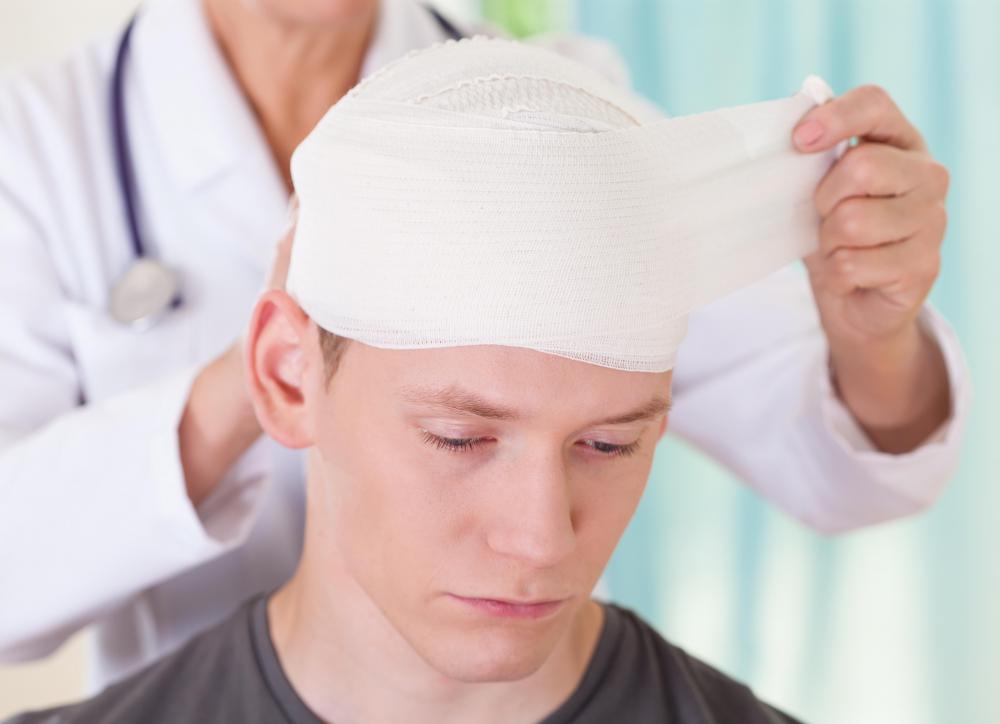At WiseGEEK, we're committed to delivering accurate, trustworthy information. Our expert-authored content is rigorously fact-checked and sourced from credible authorities. Discover how we uphold the highest standards in providing you with reliable knowledge.
What Should I Watch for after a Head Injury?
There are a variety of things to look for after a head injury, including open wounds that need stitches, signs of damage to the skull and brain, and concussion symptoms. While profuse bleeding and a goose egg bump are common, gaping wounds and cuts measuring more than a certain length will need to be stitched. Children and babies also need special attention after a head injury, as things like incessant crying and brief loss of consciousness point to brain injury. Monitoring for the following 24 hours should include watching for signs of internal damage and concussion in both adults and children, including changes in breathing, sleeping, and behavior, as well as memory and coordination.
Some effects occurring after a head injury happen even in minor cases, including profuse bleeding and the development of a "goose egg" bump, sometimes almost immediately. The bleeding is caused by the large amount of blood vessels located in the head, and the bump stems from leaking fluid under the skin. Though basic first aid is required, these factors don't necessarily point to a serious head injury. There are a number of other symptoms, however, that may signal that something needs medical attention.

Study any open wounds to see if stitches are needed after a head injury. You must first stop the bleeding by covering and placing pressure on the wound for at least two minutes. Afterwards, check for a cut that is gaping or does so when slightly tugged and measures longer than 3/16 of an inch (1/2 cm). Cuts that show red muscle or yellow fat likely need stitching, regardless of size.

If a child has experienced an external head injury, watch for incessant crying including well after the injury has occurred. This likely signals continuing pain, especially in the head and neck. A baby who cannot be consoled, isn't walking as he or she did before the injury, and experiences repeated vomiting needs medical attention. Call your doctor if your child loses consciousness, even briefly.
Children and adults should be monitored for 24 hours after a head injury occurs for signs of internal damage. During sleeping, check for normal breathing and pallor. Contact a doctor or ambulance if the victim cannot at least be partially roused.

Other symptoms may point to possible brain injury. Watch the injured for any serious wounds, if the injury was external. Bleeding or fluid discharge from the nose, mouth, and/or ear may point to brain injury, as well as changes in speech and vision, unequal pupil size, and weakness. Any paralysis, neck pain, or seizure should be reported immediately.

A concussion occurs when the brain temporarily loses some of its functioning. Signs of concussion include dizziness or seeing spots, memory loss, and vomiting, as well as headache, blurred vision, or sensitivity to light and confusion. Symptoms associated with any kind of brain injury may also signal a concussion.
AS FEATURED ON:
AS FEATURED ON:















Discussion Comments
I'm not sure if the prevailing medical wisdom still says to wake up someone every two hours after they've had a concussion. I don't think it's a bad idea, necessarily, though.
Head injuries can be deceptive, though, so keeping someone under fairly close watch for the next day or so is never a bad idea. I think about the sad case of actress Natasha Richardson, who died several hours after getting a head injury in a skiing accident, and not realizing she was hurt as severely as she was. She died rather suddenly and there was little anyone could do about it.
Post your comments